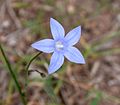| Wahlenbergia | |
|---|---|
 | |
| Wahlenbergia stricta | |
| Scientific classification | |
| Kingdom: | Plantae |
| Clade: | Tracheophytes |
| Clade: | Angiosperms |
| Clade: | Eudicots |
| Clade: | Asterids |
| Order: | Asterales |
| Family: | Campanulaceae |
| Subfamily: | Campanuloideae |
| Genus: | Wahlenbergia Schrad. ex Roth (1821), nom. cons. [1] |
| Species [1] | |
263; see List of Wahlenbergia species | |
| Synonyms [1] | |
| |
Wahlenbergia is a genus of around 260 species of flowering plants in the family Campanulaceae. Plants in this genus are perennial or annual herbs with simple leaves and blue to purple bell-shaped flowers, usually with five petals lobes. Species of Wahlenbergia are native to environments on all continents except North America, and on some isolated islands, but the greatest diversity occurs in the Southern Hemisphere.


